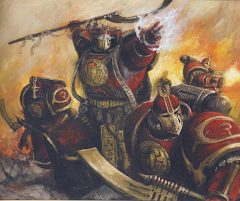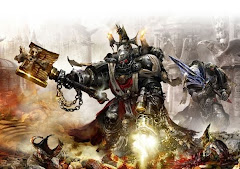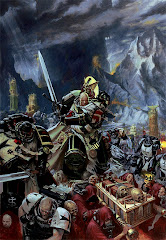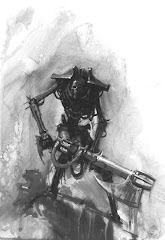When you look at a lot of the armies currently out in the player community (specifically competitive armies), you’ll notice a lot of similarities. They all tend to max out on (or heavily utilize) specific units and unit options. For instance, Chaos Space Marine armies tend to take two Sorcerers or Daemon Princes with Lash of Submission; Space Wolf armies take three units of Long Fangs; Ork armies take Power Klaws on their Boyz Mob Nobs. Why oh why do we see such horrible levels of repetition? The obvious answer is that these units and options are highly effective, so competitive armies should utilize them as often as possible. The not-so-obvious answer is that these units and options, while highly effective, have also done something else important: they’ve drowned out the desire in many players to use alternative methods or options. Why would we take Blood Angel Tactical Marines when we can instead take Assault Marines?! The players have spoken!
The fine-tuning of an army requires the examination of every aspect of its capabilities. It requires that we look at the effectiveness of the Meltagun and wonder whether or not we want a unit that can have one of them, or a unit that can take two or more; it says that we really need to go back and reconsider exactly how valuable a Nemesis Force Sword is when compared to a Nemesis Force Halberd; it makes us take Ravagers instead of Talos Pain Engines.
Essentially what all this talk of units and options comes down to is this: People mention the concept of ‘Codex Creep’ and blame it for the current perception of 40K’s lack of balance. We can get much more specific than that. It’s not army A or army B that are creating an imbalance. It’s really because of specific units and unit options available to those armies that knock things out of whack. In theory if these units and options were given adequate costs, or in some cases removed from their Codex, balance might be restored.
Before addressing specific instances of imbalance, let’s look at what armies are perceived to be unbalancing to the environment. Usually the culprits are cited to be the most recent releases: Grey Knights, Dark Eldar, Space Wolves, Blood Angels and Imperial Guard. These would be considered some of the top tier armies in the game at the moment, followed closely by Chaos Space Marines, Orks, Space Marines, Black Templars and Tyranids. The imbalance between these two groups is minimal. However, when compared to some of the other armies out there (most of which are older), the imbalance becomes much more obvious. In comparison to the previously listed armies, Tau, Necrons, Sisters of Battle, Chaos Daemons, Dark Angels and Eldar are all performing at sub-par levels.
The main issue that’s currently linked to 40K’s imbalance is the concept of immunity. Immunity is the inability of a unit to kill an opposing unit no matter what. We’ve all seen great examples of this, and anyone who’s ever had their Imperial Guard infantry ‘blob’ squad get charged by a Wraithlord knows exactly what I’m talking about. If the IG unit isn’t equipped with a Powerfist they simply wait for the Emperor’s Peace. Aside from the variable level of immunity that high toughness can provide, immunity also exists, most importantly, in the form of armor value (or AV for short). AV actually provides an even greater level of immunity than high toughness, but does it in a slightly different way. While units with high toughness are functionally the same as every other unit with a toughness value (it functions the same, no matter how many wounds it’s taken, until it’s removed from play), units with AV may gradually suffer varying levels of damage and drop in effectiveness until they’re removed. There are many instances in which AV units are incapacitated, but remain in play; the only real risk these units face is the chance that they may be destroyed by a single attack.
The second issue affecting imbalance (which is related directly to immunity) is the reduction in costs of transport vehicles. All Space Marine armies, with the exception of Black Templars, now pay a mere 35 points for Rhinos. Chimeras now run 55 points. Dark Eldar transports have proportionate costs; they’re more expensive, but have much stronger ranged capability and speed; the inexpensive costs of their units allow them to field a vast number of these vehicles. Top tier armies now have the ability to field ‘mech’ (highly mechanized) configurations by taking a horde of both transport and support vehicles.
Because of the issues of immunity and vehicle cost reduction, 40K now lies in stark contrast with the game it once was. The sheer quantity of armored units being fielded in games puts a whole new level of pressure on armies to function in ways that they’re relatively unprepared for. In Fifth Edition there is an emphasis placed on squads (and sometimes other units) occupying specific table locations, so the tendency in army configurations is to lean towards hefty amounts of anti-troop weaponry. Now armies must be able to deal with that large quantity of both troops and armored units. The main difference between an older Codex and a newer one is boiling down to one simple factor: Can it compete with newer armies that both pay less for their vehicles and have a greater capacity for dealing with an opponent’s vehicles?
So what classifies a unit (or option) as being an agent of imbalance? My theory is that its mere existence allows an army the capability, for the moment, to keep its head above water. While lower tiered armies are struggling to raise themselves higher on the power ladder, top tier armies are attempting to gain dominance by filling their ranks with as many anti-tank weapons as possible; somehow they maintain their ability to kill enemy troops by normal means.
Space Wolves
Codex Space Wolves contains a couple great examples of unbalancing agents. The majority of units in this book have a great close combat capability. They also have access to a large amount of short-range weaponry (a number even greater than that of C:CSM). If the capabilities of the army ended there I’m sure the ‘Wolves would have a cohesive identity – Wulfen, Thunderwolves, Bikers, Wolf Guard, Wolf Lords, and a whole slew of other nifty close combat units and their associated transports…and maybe a few extraneous, yet traditional, Space Marine units like the Predator and the Land Speeder. Yet somehow there is this amazing unit in the codex – Long Fangs – that have neither close range weaponry, nor the ability to excel in close combat. It doesn’t surprise me when uncharacteristic units show up in a codex. It’s bound to happen when designers are trying to satisfy design requirements; they are servants to way too many masters. However, when the inclusion of an uncharacteristic unit is necessary, then its cost must reflect its irregularity. Instead, what we have is a unit whose cost was lowered, its option costs were lowered, and its traditional ‘splitting fire’ capability was left in place. Not only is the unit overly cost-efficient, but it also satisfies the army’s need for long-range fire support. Instead of paying for a Predator Annihilator you can pay even less for fifty percent more shots, six wounds, and a troop unit’s ability to take cover saves. What else could the Space Wolves ask for when it comes to ranged, anti-tank capability? This unit is ideal for boosting the Space Wolves into the top tier slot in our new, competitive, heavy-mech environment.
The other option available to Space Wolf armies is the psychic power Jaws of the World Wolf. This one really is on par with the Fourth Edition C:SM psychic power Fear the Darkness. JotWW is yet another ranged attack that is multi-purpose, easy to use, low in cost and available in high frequency. Its versatility is amazing. However, if you want true versatility for your SW army you would take Living Lightning because it also has the potential to hurt vehicles. Thankfully Rune Priests can take two psychic powers so you don’t have to make that difficult choice!
Blood Angels
The next army riding the Rhino bandwagon is Blood Angels. The Rhino, however, is just one reason BA are a top tier force. If anyone remembers the days of Fourth Edition 40K, they’ll recall the old Space Marine system of bonuses and drawbacks (the exact nomenclature escapes me at the moment). Back then it was possible for your troops to have two close combat weapons plus two special weapons (e.g. meltaguns) per squad; they could be mounted in a transport as well. Why use Tactical Squads that, while flexible, aren’t particularly good at any one thing? Assault Squads mounted in Rhinos are far more effective. This is the crux of C:BA. If they had to rely on traditional SM Tactical Squads and Scout Squads for their Troops, they wouldn’t be the ultra-flexible army that they are – able to attack an opponent with overwhelming force, yet able to fall back on the reliability of that force for taking objectives.
Another important element that Codex: Blood Angels incorporates is the ‘broadcasting bubble.’ Lots of units have abilities like this (e.g. Venomthrope and Ezekiel), but none give such amazing bonuses as the Sanguinary Priest. When a 50 point model gives everything within a 12” diameter bubble (larger if he’s mounted in a transport) Feel No Pain and Furious Charge, there’s definitely an issue of cost afoot. Did I mention that this model is also capable of being equipped like a character? Did I mention that he can be hidden in a transport? The only thing comparable to this that I’ve seen so far is the Black Templar vow that gives Preferred Enemy to the entire army… but even that ability doesn’t provide the amazing defensive capability of Feel No Pain.
Grey Knights
The release of Codex: Grey Knights a few months back garnered some ooohs and aaahhs. The massive knee-jerk reaction to the army stemmed mainly from its massive incongruency with the standard Codex: Space Marines. Now, two hundred forty points could buy you ten Space Marines with strength five power weapons and twenty Storm Bolter shots per turn… not to mention their Rhino that ignores Shaken and Stunned results. In C:SM your scoring units don’t have options that come even remotely close to this. C:SM must rely on characters and supporting units (which they have sufficient access to) to win their games. C:GK has units that are much, much closer to being ‘all-purpose.’ Are the two books relatively balanced? Sure. I actually think that C:GK got the short end of the stick, except in three specific cases where it got some units and options that simply slam certain other armies back into the stone age.
The first ridiculous GK option is the psychic power Cleansing Flame. This psychic power is just amazing. It’s so amazing that it utterly destroys any army that relies on large numbers of lightly armored troops. If you’ve ever seen two 30-man Ork Boy units get multi-charged by a single unit of Purifiers, then you know what I’m talking about. Normally a unit of 30 Boyz is enough to kill an entire unit of ten Tactical Marines in one charge. Purifiers, however, need only set off Cleansing Flame in order to watch just under half of those Orks evaporate before combat even begins. Even with the protection of Shadow in the Warp, Tyranid swarm units of Hormagaunts, Termagants and Gargoyles often suffer a similar fate. Unfortunately, Orks don’t have any special rules or wargear that cut down on the effectiveness of psychic powers like the Tyranids do. Were the Dark Eldar not so heavily permeated by units with Feel No Pain due to the Power From Pain rules, they would suffer nearly as much as the Orks do. Cleansing Flame’s issues are many, but its problem is its ability to win the initiative war. Do your Howling Banshees strike at initiative ten? Sorry. Cleansing Flame strikes first. Do your Bloodletters have Furious Charge? Sorry. Go home, Daemons. I know you thought you were a balanced army because you have to Deep Strike, but now you just suck a lot more. The older Codex: Daemonhunters didn’t allow for its Holocaust psychic power to be used before blows were struck in combat. Additionally, its range was limited to, IIRC, a large blast template. Cleansing Flame not only hits every model in a unit touching its user, but it also has super-uber initiative, allowing it to remove opposing models before they’re able to participate in combat.
While it makes a certain amount of sense for psychic powers to be able to break close combat initiative barriers, it seemingly makes little sense for a piece of common wargear with static properties to allow for a similar effect. The Nemesis Force Halberd isn’t actually that amazing, except that it allows heavy-hitting units (like GK Terminators and Paladins) to get their licks in before most things capable of hurting them are able to attack. Terminators don’t worry too much about piecemeal close combat attacks from medium or low strength units. They worry about the big stuff – Hive Tyrants, Nob Bikers with Power Klaws, Thunderwolf Cavalry, Bloodcrushers, and any variety of other Monstrous Creatures that have tons of armor-negating attacks. It’s quite convenient to have the ability to easily inflict Instant Death upon most any big-bad unit that might be able to make life difficult. The Halberd is just too convenient of a fix for many weaknesses the army might have.
Finally, the number one unit that gives Codex: Grey Knights the ability to compete at top tier level is the oft-hailed ‘Psyfleman’ Dreadnought. If anyone doesn’t already know where this title comes from, here it is: In FASA’s game, Battletech (originally called Battledroids), there is a mech called the Rifleman which possesses two arms, each with two long-barreled guns. 40K Marine Dreadnoughts, when equipped with a pair of twin-linked Autocannon arms, bear a striking resemblance to that old Battlemech (whose artwork was, ironically, ‘borrowed’ from the old Robotech license in which the ‘Destroid’ was called the Raider-X). Please excuse me if I’ve mixed up any of the names and/or terms… that’s just how I remember them. Back to the GK Dreadnought… This unit has a similar effect to that of the Space Wolves’ Long Fangs. Yet again we have a unit that takes the weakness of a Codex and almost completely erases it. Many GK units are meant to be multi-purpose due to their high points costs, and because of this they have access to the all-powerful Psycannon. The Psycannon does, however, come with the drawback of a lower rate of fire if used by a unit on the move. This drawback isn’t suffered by Psycannon-wielding Terminator units because they have obvious issues in the transportation department. There’s also the issue of the Psycannon’s 24” range keeping its power level in check. So the intended drawbacks for the army’s main gun are: Low rate of fire, relatively short range. So what do they get? They get high rate of fire, twin-linked, high strength, long range weapons whose wielder has the ability to ignore vehicle damage results that would otherwise prevent them from firing. This is not the way to keep the integrity of a Codex intact. All this did was catapult the army straight into the ridiculous vehicle/anti-vehicle immunity-busting contest existing at the top tier.
Dark Eldar
Codex: Dark Eldar has gotten a ton of press since its release. Some people think it’s a god-awful pile of brokenness, but in actuality, it’s the most balanced of the top tier forces. Does it dive headfirst into the pool of immunity-busting polarity? Definitely. However, the book’s greater level of balance comes from the weaknesses of their vehicles – low AV and open-topped. Because so many vehicles in the DE list have AV10, they’re more susceptible to low-strength weaponry. Combine this vulnerability with the Open-Topped trait and you have a minimal level of immunity that’s easily overcome by most armies.
The first source of imbalance in Codex: Eldar is the Blaster. Why the Blaster? What did the Blaster ever do to piss me off? The Blaster is actually just part of a bigger problem, but I figured that it was a good starting point. Because the vast majority of the basic weaponry in C:DE has no actual strength value, it probably became apparent during testing that they lacked that little extra oomph, for instance, that all the Space Marine armies have: Krak Grenades and strength 4 Bolters both help them get over the immunity hump. What do the DE have that let them get over that hump? They don’t have any cheap, free wargear on every model like the Space Marines do. What they got instead were a pile of strength 8 Lance weapons – Blasters and Dark Lances – that are plentiful enough to make Land Raiders everywhere wish, once again, that they had stayed safely on the battle barge. Back to the blaster. Dark Lances have always been the DE staple anti-tank gun, but with the increase of the Blaster’s range to 18” the available quantity of anti-tank fire has doubled, and in some cases (Kabalite Trueborn) tripled. The ability of these guns to be fired at a decently long range while moving gives them a massive advantage that many armies can’t match. The Ravager is the army’s second source of imbalance, as it allows for massed, cheap anti-tank fire, adding to the horrible barrage already compounded by the blaster… or perhaps it’s the other way around. The Dark Eldar should have been forced to rely more heavily on things like Haywire Grenades, Blast Pistols and high-strength close combat attacks to take on tanks. As it stands, they simply evade and shoot until their opponents are pulped before moving in to finish them off.
Imperial Guard
When we take a look at Codex: Imperial Guard we basically see three things: units that dish out pain at long range, units that allow the army to continue to continue to use its long-range firepower, and everything else. Since it’s the ‘Guard’s lot to be shooty, and since there’s nothing wrong with ranged combat (because it’s an essential part of the game), where does the codex cross the line? There’s one major factor that takes it too far, and that’s frequency. The high frequency of unit weapon options is where the army jumps the shark. The main culprits of this balance violation are Veterans, Heavy Weapons Squads, and the almighty lockbox, the Chimera. I’ve already addressed the issues of low-cost transports upping the ante in the immunity clash, but the Chimera is special. The standard Rhino carries ten passengers and a small gun. The Chimera has more firepower, more fire points, higher front armor, and additional vehicle options. If Space Marines had the option of purchasing fifty-five point Chimeras instead of their Rhino upgrade, the already widely used eighty point Razorback, would they? Of course they would. They’d be able to use the Chimera for ten-man units, allowing them maximum weapons upgrades for their squads. They’d be able to use the Chimera as a firing platform for their Devastators. The list of benefits goes on. There’s just no need to give the IG this sort of option for such a low cost.
The other perpetrators in the IG army are those units that greatly benefit from the overabundance of weapon options. Heavy Weapons squads throw the IG into a whole new realm of anti-vehicle competition. What other army can take units of two-wound models that dish out six S7 shots for seventy-five points? …that are scoring? …that can take cover saves? …that essentially don’t take up a force org slot? None. But wait! I won’t even continue down this path of reasoning because it’s futile to continue in the face of such blatant undercosting and underenforcement. Need I repeat myself about the Veteran squads?
So really, what’s the point to all this complaining about these units and options? I just want to reiterate how much the game of 40K has upped the ante when it comes to the immunity war, as well as how drastically the top tier armies have pushed other armies out of the running. What happens next? If you were to re-balance 40K, would you re-write the rules for these units and options? Would you outright ban them? Personally I feel that banning is a far easier option (no messy FAQs, rules re-writes, conflicting knowledge of unit functions, format discrepancies, etc.), but since this is a hobby game and not a CCG, players have put a ton of time and effort into their armies. They don’t want to simply write their beautifully *cough* painted and modeled armies on a shelf somewhere. Perhaps it’s up to some of these independent tournaments to create new, meaningful missions that allow us to indulge ourselves differently? Perhaps the scoring system should be re-worked in order to scale down the high stakes of immunity-based games?
Monday, October 10, 2011
Subscribe to:
Post Comments (Atom)






























No comments:
Post a Comment